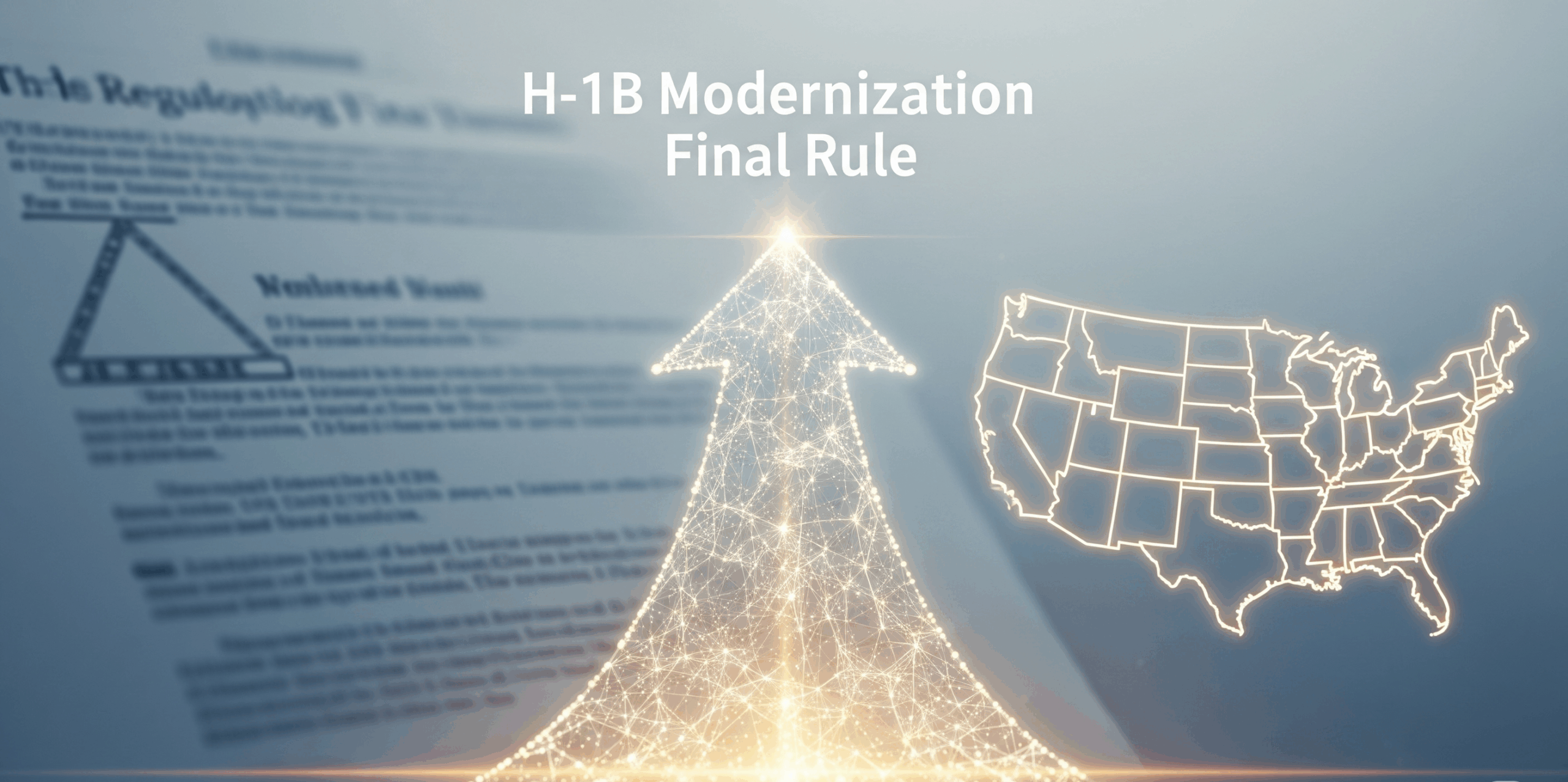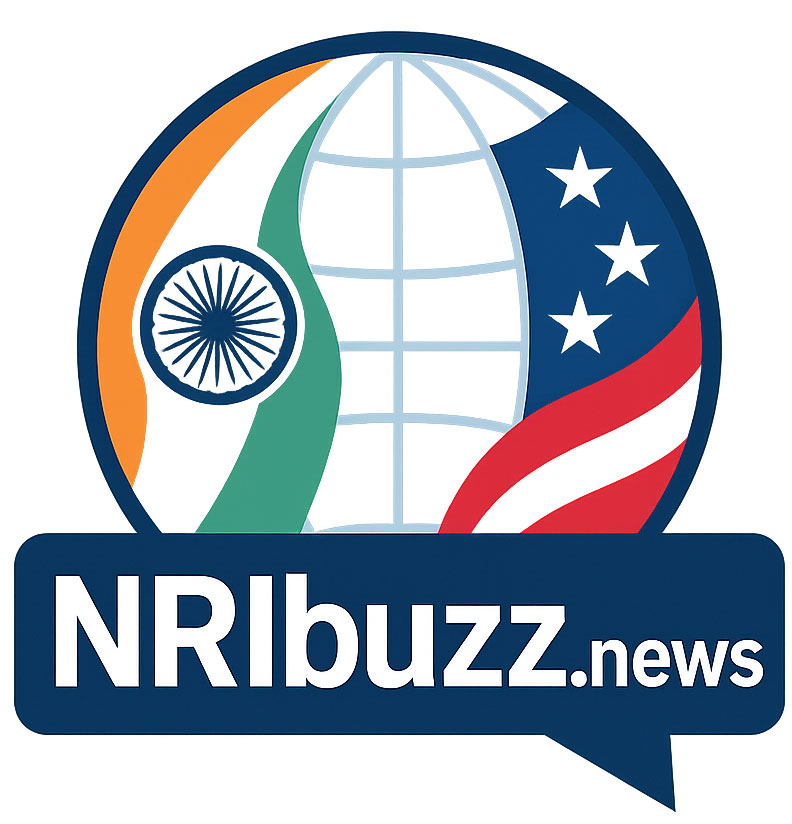1. The New H-1B Rulebook: What Just Changed and What’s Coming

If you’ve had your eyes on the H-1B visa arena lately, you’ve probably sensed something big was shifting. And indeed—it’s not just about registration anymore. From modernization rules, to a looming wage-based lottery, and even family eligibility changes, here’s all you need to know.
1- H-1B Modernization Final Rule – Effective January 17, 2025
What Changed?
The Department of Homeland Security and USCIS implemented sweeping updates through a final rule published December 18, 2024, and rolled out fully on January 17, 2025. These changes aim to modernize the H-1B system by improving flexibility, integrity, and employer access.U.S. Department of Homeland SecurityCUPA-HRHolland & Knight
Key updates include:
- • “Specialty Occupation” Definition Clarified
Employers must show roles normally require a bachelor’s degree directly related to job duties—providing more practical scope than the previous strict wording.Holland & KnightCUPA-HR - • Employer Flexibility for Entrepreneurs & Remote Work
The rule expands H-1B eligibility to include startups and beneficiary-owned companies, as long as they have U.S. presence, IRS tax ID, and a bona fide job offer—even if remotely performed.Frost Brown Todd - • Deference to Prior Approvals
USCIS will now generally defer to past Form I-129 approvals when the facts and eligibility remain the same—unless there’s a material change or error—saving time in renewals.Holland & KnightPenn Global - • Stronger Integrity and Oversight
Site visits are now codified—including at third-party or remote work sites. USCIS now has more authority to inspect and take action for non-compliance.Frost Brown ToddPenn GlobalFederal Register - • Cap Exempt Clarifications
Nonprofits and research outfits—with proper IRS classification—can claim cap-exempt status even if research isn’t their primary activity.Frost Brown Todd
Why It Matters: These updates level up the H-1B process—making it more transparent and flexible, especially for startups and renewals—while ensuring the system stays fair and compliant.
2- Cap Registration: Still in Play—but Cleaner
USCIS continues its electronic beneficiary-centric selection, rolled out earlier in 2024, which eliminates multiple filings per beneficiary and improves integrity. For FY2026, USCIS selected roughly 118,660 beneficiaries—hitting both the general (65k) and master’s (20k) caps.USCIS
Key Pro Tips:
- • Use the correct, organization-level account at USCIS.
- • Pay the now-standard $215 per beneficiary during registration.
- • Track your timeline carefully—March 7 to March 24 for registrations; selection notifications typically by March 31.
3- Lottery Or Wage-Based? A Major Shift Could Be On Its Way
In a move approved by the White House’s OIRA on August 8, 2025, a proposed rule aims to replace the traditional lottery with a wage-priority system, favoring applications tied to higher salaries.The Times of India+1The Economic Times
Implications:
- • Higher salary jobs prioritized—not necessarily better talent.
- • New grads and entry-level roles may face steep competition.
- • Employers might need to reconsider job offers and compensation to stand out in the selection process.
Note: This is a proposal, not yet final. Stay tuned—it’s expected to be published publicly soon for comment.
4- H-1B Interviews: Face-to-Face is Back (From Sept 2025)
Starting September 2, 2025, most H-1B visa applicants can no longer expect interview waivers. In-person interviews at U.S. consulates are becoming mandatory—with few exceptions.The Times of India
What You Should Do:
- • Practice dual intent messaging (good job now, green card aspirations later).
- • Organize all supporting documents neatly and comprehensively.
- • Factor in longer wait times and logistical hurdles when planning submissions.
5- Family Matters: CSPA Rule Makes Age-Outs a Bigger Concern
USCIS changed how they calculate dependent children’s ages under the Child Status Protection Act (CSPA)—effective August 15, 2025. The law now relies on “Final Action Dates” rather than loosely defined “filing dates.”The Economic Times+1The Times of India
Effects:
- • Children may age out (turn 21) more easily if approvals move slowly.
- • Families must re-evaluate immigration timelines and possibly explore alternative visa paths sooner.
Summary Table: What Changed & What’s Coming
| Change | Effective Date | Key Impact |
|---|---|---|
| H-1B Modernization Rule | Jan 17, 2025 | Flexibility, oversight, startup-friendly |
| Electronic Registration | Since Mar 2024 | Streamlined, beneficiary-based selection |
| Lottery to Wage-Based Rule | Proposed (2025) | Prioritizes higher-paying jobs, yet unfinalized |
| Mandatory Interviews | Sept 2, 2025 | Face-to-face required for most applicants |
| CSPA Age Calculation Change | Aug 15, 2025 | More children risk aging out of green card eligibility |
What This Means for Key Stakeholders
Employers:
- • Take advantage of startup sponsorship flexibility.
- • Prepare for more audits and keep detailed records.
- • Monitor the wage-based rule—may need to adjust salaries strategically.
Job Seekers / Graduates:
- • Higher salaries may no longer be “just nice to have”—they could become essential.
- • Plan for interview prep and timelines.
- • If you have children, factor earlier into green card planning.
Families on H-1B Paths:
- • The CSPA change is a clear red flag for aging-out risks.
- • Explore alternate routes like F2B, F1 STEM extension, or employment-based paths earlier.
Final Thoughts
2025 is a pivotal year for H-1B visa policy—modernization is underway, but so is competitive pressure on applicants. Whether you’re an employer, young professional, or family sponsor, awareness and preparedness are your greatest tools.
2. Double Trouble: Why You Need to Be Extra Careful Traveling to the U.S. on a Business Visa

For decades, the United States has been the epicenter of global business travel. From high-powered executives attending boardroom meetings in New York, to tech professionals flying to Silicon Valley for conferences, the B-1/B-2 visa has been the gateway for millions of international travelers. But here’s the catch—what was once considered a routine process has now turned into a minefield of risks.
If you’re planning to travel to the U.S. on a business visa in 2025, you need to know this: the scrutiny is tougher, the rules are stricter, and the consequences of missteps are harsher than ever. What used to be “just another business trip” can now easily spiral into “double trouble”—with risks at both the immigration counter and for your future visa prospects.
Let’s break this down.
What is a Business Visa (B-1/B-2)?
First, let’s get the basics out of the way. The U.S. issues B-1 visas for business activities and B-2 visas for tourism, often combined into one document (B-1/B-2).
On a B-1 visa, you are allowed to:
- • Attend conferences, conventions, and trade shows
- • Negotiate contracts
- • Meet with clients, vendors, or partners
- • Participate in short-term training (non-employment)
- • Conduct independent research or fact-finding
But here’s what you are not allowed to do:
- • Work for a U.S. employer
- • Receive a salary or wages from a U.S. source
- • Engage in “hands-on” employment, even for a short duration
- • Stay for long periods in a way that looks like “living in the U.S.”
The line seems clear on paper. But in real life, it’s blurry, subjective, and open to interpretation by the officer at the port of entry. And that’s where the new trouble begins.
Why Business Visa Travel is Under the Microscope in 2025
Several factors have made business visa travel a red flag for U.S. immigration authorities:
- Work Misuse Cases are Piling Up
Too many travelers have been entering on a business visa and actually working in the U.S. This includes foreign employees being sent by multinational firms to do projects that should have required H-1B or L-1 work visas. - Tighter Immigration Environment
After years of policy debates, the U.S. is in a season of tightening immigration loopholes. The Department of Homeland Security (DHS) and Customs and Border Protection (CBP) officers have been instructed to carefully screen short-term visitors. - H-1B and Work Visa Backlogs
With H-1B slots limited and processing delays common, some companies try to send workers on B-1 visas for “urgent” projects. Immigration authorities are cracking down on this practice. - AI + Data Tracking
U.S. immigration is now using advanced data systems to track your travel history, job profile, and even LinkedIn activity. If your story doesn’t match, it can be flagged in seconds.
Bottom line: If you’re traveling on a business visa, every answer you give is now under a microscope.
The “Double Trouble” Scenario
Why am I calling it double trouble? Because the risk comes at two levels:
- Trouble at the Port of Entry
Even if your visa is stamped and valid, the CBP officer at the airport makes the final call. They can:
- • Allow you in for a short stay (sometimes less than 6 months)
- • Send you for secondary inspection (hours of questioning)
- • Deny you entry and send you back on the next flight
- • Cancel your visa on the spot if they believe you misrepresented your purpose
Imagine landing after a 16-hour flight and suddenly being grilled about your employer, your role, your intent, and your LinkedIn profile—yes, officers check it live sometimes. That’s level one of trouble.
- Trouble for Your Future Visa Record
Even if you somehow manage to enter, your answers are recorded. If CBP notes that you admitted to “helping with a project” or “working with a U.S. team,” you may have just jeopardized your chances for future visas like H-1B, L-1, or even green cards. Misuse of a business visa can be interpreted as fraud or misrepresentation, which is a permanent black mark.
That’s level two of trouble.
Real-Life Situations That Raise Red Flags
Here are common scenarios where travelers unknowingly get into trouble:
- • “I’m going for training.”
→ Training is allowed, but only if it’s passive observation or classroom-style. If you’re actively doing work for a U.S. office, that’s considered employment. - • “I’m visiting clients.”
→ Fine, but if you’re actually managing their systems, coding, or providing hands-on work, it’s beyond the B-1 scope. - • “I’m here for meetings for 3 months.”
→ Long stays, even for “meetings,” make officers suspicious that you’re actually working. - • “My company is paying for this trip.”
→ Payment for travel is okay, but salary or project compensation in the U.S. is not. - • Frequent Travel Pattern
→ If you’re entering multiple times in a year, it looks like you’re living/working in the U.S. on a business visa.
How to Stay Safe While Traveling on a Business Visa
Here are some practical tips to avoid double trouble:
- Be Clear on Your Purpose
Always know exactly what you’re going to do—and how to explain it in plain language. Keep your story consistent with your invitation letter, itinerary, and LinkedIn profile. - Carry Proper Documentation
- • Invitation letter from the U.S. company
- • Conference registration proof
- • Return flight tickets
- • Hotel bookings
- • A letter from your employer stating your role and the purpose of travel
- Avoid “Work” Language
Words like “project,” “implementation,” “deploy,” “fix,” or “work with the team” can trigger alarms. Instead, use terms like “meeting,” “discussion,” “knowledge sharing,” “negotiation,” or “observation.” - Keep Your Stay Short and Clear
A few weeks for meetings looks normal. Months of stay looks suspicious. - Don’t Carry Work Tools
Showing up with large toolkits, laptops full of project files, or presentation decks meant for U.S. clients can backfire. - Be Honest, But Precise
Never lie—but also never volunteer unnecessary details. Answer what’s asked, directly and clearly.
What Happens If You’re Denied Entry?
Getting turned away at the airport is not just embarrassing—it’s serious. You may:
- • Get your visa canceled
- • Face difficulty applying for future visas
- • Have a permanent note in your immigration record
In some cases, you may also face a five-year ban if CBP concludes you misrepresented your purpose.
Looking Ahead: Why Companies and Travelers Must Adapt
The truth is, business travel is not dying—but it’s transforming. With stricter scrutiny, both companies and employees must adapt:
- • Companies should stop using B-1 visas as a shortcut to send employees for work.
- • Employees should educate themselves on the limits of their visa.
- • More organizations will need to invest in proper work visas (H-1B, L-1, O-1) instead of “risking it” with business visas.
In the long run, being cautious now saves you from far bigger legal and career consequences later.
Final Word
Traveling to the U.S. on a business visa in 2025 is no longer routine. It’s a balancing act—where one wrong word at immigration can derail not just your trip, but your career. The rules haven’t changed much on paper, but the enforcement has become ruthless.
That’s why you need to think twice, prepare thoroughly, and play it safe. Because in today’s climate, traveling on a business visa isn’t just business as usual—it’s business with double trouble if you’re not careful.
3. What Can Get You Sent Back on a Student Visa in the U.S.?

Studying in the United States is a dream for millions of international students. But here’s the not-so-pretty truth: holding a U.S. student visa (typically F-1) is not a golden ticket. The visa lets you approach the gate, but whether you can stay in the country depends on how well you follow the rules. Mess up once—intentionally or by accident—and you could find yourself on the next flight home.
So, what can actually get you sent back (denied entry or removed) while on a student visa? Let’s break it down.
- Lying or Misrepresenting Information
Let’s start with the biggest red flag. Immigration officers don’t play around with dishonesty. If you’ve:
- • Lied on your visa application,
- • Falsified financial statements, or
- • Given inconsistent answers at the airport,
you risk being denied entry immediately. Even a “small” fib—like saying you’ll only study but secretly planning to work full-time—can get you tagged with visa fraud. That’s not just a rejection; it’s a potential lifetime ban.
Pro tip: If your situation changes (say, you got married or moved addresses), report it properly instead of hiding it.
- Violating the “Full-Time Student” Requirement
The F-1 visa isn’t a casual pass—it comes with strings attached. One major condition is that you must stay enrolled as a full-time student at your institution. Drop below the required course load without authorization, and you’re immediately out of status.
Why does this matter? Because “out of status” = subject to deportation. USCIS doesn’t really care if you were sick, homesick, or just couldn’t handle the workload—unless your Designated School Official (DSO) approves a reduced load in SEVIS, you’re breaking the law.
- Unauthorized Employment
This is the most common way students get into trouble. An F-1 visa strictly limits employment:
- • On-campus jobs (up to 20 hours/week during school) are fine.
- • Off-campus jobs usually require special authorization like CPT (Curricular Practical Training) or OPT (Optional Practical Training).
Working at a restaurant, driving Uber, freelancing online, or even getting paid under the table—all illegal. Immigration has cracked down on this hard. If caught, you risk losing your visa immediately.
And yes, they can find out—through tax records, random checks, or even a jealous roommate tipping them off.
- Travel Mistakes at the Border
Here’s where many students get blindsided. Having a valid visa doesn’t guarantee re-entry into the U.S. Each time you come back from abroad, Customs and Border Protection (CBP) decides whether you’re admissible.
You can be sent back if:
- • You’re carrying the wrong or expired paperwork (like an outdated I-20).
- • You can’t prove you have enough money to cover tuition and living costs.
- • You give inconsistent answers (e.g., saying you’re here to “work” instead of “study”).
- • You have items in your luggage that raise suspicion—like stacks of résumés or work tools suggesting unauthorized employment plans.
CBP officers are trained to sniff out intent. If they think you’re entering for reasons beyond study, you could be turned away on the spot.
- Criminal Charges or Arrests
This one’s obvious but worth spelling out: if you get arrested in the U.S., even for something that feels “minor,” it can put your status at risk. Charges like DUI, shoplifting, or drug possession often lead to termination of your SEVIS record.
Remember: the standard isn’t always conviction—it’s whether USCIS thinks you’ve violated the “good moral character” requirement. And immigration law can be harsher than criminal law. Something that seems like a slap on the wrist in court could mean visa cancellation.
- Failing to Maintain SEVIS Compliance
Every F-1 student has a digital file in the SEVIS system (Student and Exchange Visitor Information System). It’s like your academic + immigration report card. Schools must update it whenever you:
- • Change address,
- • Switch majors,
- • Transfer schools, or
- • Take a leave of absence.
If you don’t notify your DSO and keep SEVIS updated, your record can be terminated. Once that happens, you’re officially out of status—even if you’re physically still attending class.
- Overstaying Your Authorized Stay
Many students confuse their visa expiration date with their authorized stay (the date on your I-94). They’re not the same.
- • The visa in your passport is just an entry document.
- • Your I-94 card (issued at the airport) shows how long you can remain.
F-1 students usually get a “D/S” (Duration of Status), meaning you can stay as long as you’re properly enrolled. But if you graduate, drop out, or violate status, the clock starts ticking. Overstay your grace period, and not only can you be deported, but you may also trigger 3-year or 10-year bans on re-entry.
- Financial Problems
Remember how you had to show proof of funds when applying for the visa? That wasn’t just for fun. The U.S. expects you to actually maintain those funds while studying.
If you suddenly can’t pay tuition, get evicted, or rely on unauthorized work to survive, it raises red flags. At re-entry, CBP can ask for updated financial proof—and if you can’t show it, you might be denied entry.
- Engaging in Prohibited Activities
This includes:
- • Political activities that break visa rules (joining protests isn’t illegal, but violent or disruptive activity is).
- • Using your student visa as a cover for something else (like starting a business).
- • Marrying a U.S. citizen just to “fix papers”—immigration calls this marriage fraud, and the penalties are brutal.
- Carelessness with Documents
Sometimes, it’s not intentional fraud or crime—it’s just carelessness. Students have been sent back for:
- • Forgetting to carry a valid I-20 signed for travel,
- • Having expired passports,
- • Losing I-94 records,
- • Carrying outdated SEVIS information.
Immigration doesn’t forgive paperwork mistakes easily. If your documents don’t line up, you’re at risk.
The Bottom Line
An F-1 visa is a privilege, not a guarantee. The rules may feel strict—even unfair—but they’re enforced rigorously. What sends students back usually falls into three buckets: dishonesty, unauthorized work, and failure to maintain proper status.
If you’re a student, the safest strategy is simple:
- • Stay in touch with your DSO,
- • Keep your SEVIS record accurate,
- • Avoid shortcuts like unauthorized work, and
- • Be prepared at every border crossing.
The U.S. welcomes international students, but it also guards its borders with vigilance. Don’t let small mistakes send you home early.






